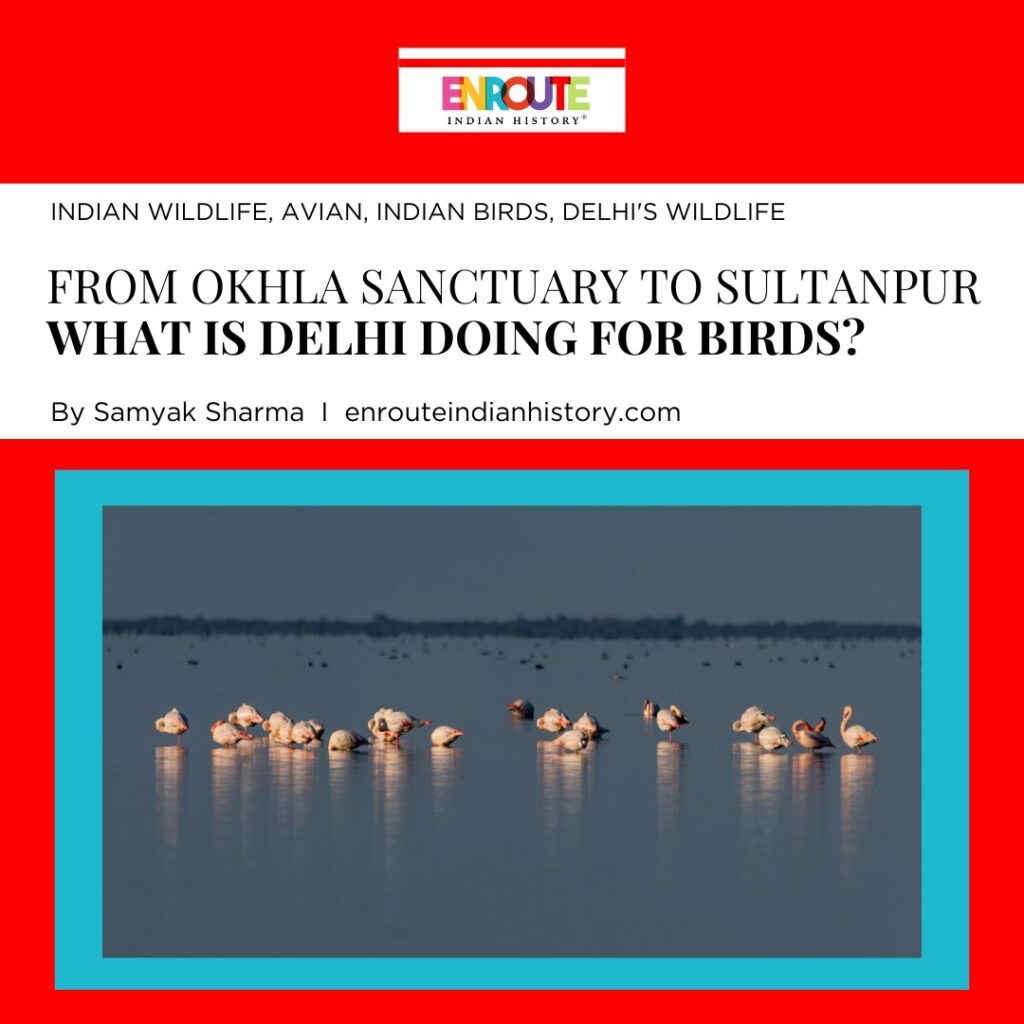From Okhla Sanctuary to Sultanpur what is Delhi doing for birds?
- enrouteI
- March 1, 2024

Delhi, the bustling capital city of India, is not only known for its rich history, culture, and diverse population but also for its remarkable avian biodiversity. Despite being a densely populated urban center, Delhi is home to a wide array of bird species, making it a haven for birdwatchers and nature enthusiasts. In this comprehensive article, we will delve into the avian life of Delhi, focusing on prominent birding sites such as Okhla Bird Sanctuary, Sultanpur National Park, the Yamuna River, and Hauz Khas Lake. Through exploring the history, facts, and figures of these locations, we aim to shed light on the vibrant avifauna that thrives in the heart of India’s capital.

Source: Times of India
History of Avian Conservation in Delhi
The history of avian conservation in Delhi is a testament to the city’s enduring commitment to preserving its natural heritage amidst rapid urbanization and development. While Delhi is primarily known for its rich history, culture, and bustling city life, its avian biodiversity has also been a subject of conservation efforts dating back several decades.
One of the pivotal moments in the history of avian conservation in Delhi occurred in the late 20th century when awareness about environmental degradation began to grow globally. As urbanization accelerated, natural habitats faced increasing threats from human activities such as deforestation, pollution, and habitat destruction. Recognizing the need to protect and preserve the city’s avian diversity, conservationists and environmentalists initiated efforts to establish sanctuaries and protected areas.
One of the earliest initiatives in avian conservation was the establishment of Okhla Bird Sanctuary in 1990. Situated at the confluence of the Yamuna and the Hindon rivers, Okhla Bird Sanctuary was designated to safeguard the diverse bird species that inhabit the wetlands and marshes surrounding the rivers. Initially spanning a modest area, the sanctuary gradually expanded to over 4 square kilometers, providing a vital refuge for both migratory and resident bird species.

Source: Treebo
Another significant milestone in Delhi’s avian conservation history was the transformation of Sultanpur National Park from a hunting ground to a bird sanctuary in 1971. Originally used as a hunting reserve by the Maharajas of Gwalior, Sultanpur National Park underwent a remarkable metamorphosis to become a haven for avian life. The park’s wetlands and marshes attract a plethora of migratory birds during the winter months, turning it into a paradise for birdwatchers and nature enthusiasts.
Over the years, Delhi has witnessed the establishment of several other protected areas and green spaces aimed at conserving avian habitats. These include urban parks, nature reserves, and biodiversity hotspots, each playing a vital role in sustaining the city’s avian biodiversity amidst urban development pressures.

Source: Viator
Despite these conservation efforts, Delhi’s avian habitats continue to face numerous challenges. Rapid urbanization, pollution, habitat loss, and encroachment pose significant threats to the survival of bird species in the region. The Yamuna River, in particular, faces severe pollution issues, endangering the aquatic bird species that depend on its waters for survival.
To address these challenges, various conservation initiatives have been undertaken by government agencies, non-profit organizations, and local communities. These efforts include habitat restoration, wildlife monitoring programs, public awareness campaigns, and policy advocacy aimed at promoting sustainable coexistence between birds and urban dwellers.
The history of avian conservation in Delhi reflects the city’s commitment to preserving its natural heritage and biodiversity. Despite being a densely populated urban center, Delhi has emerged as a haven for bird species, thanks to the concerted efforts of conservationists and environmentalists. As the city continues to grow and evolve, it is essential to prioritize the conservation of avian habitats and ensure the continued survival of Delhi’s vibrant avifauna for future generations to cherish and enjoy.
Winged Wonders: Discovering Delhi’s Diverse Birdlife
Delhi’s avian life is as diverse as the city itself, boasting a wide array of bird species that inhabit its various habitats, from urban parks to wetlands and riverbanks. The history of avian life in Delhi is intertwined with the city’s evolution, shaped by its geographical location, climate, and human activities.
One of the most iconic birds of Delhi is the House Sparrow (Passer domesticus). Historically, these small, chirpy birds were abundant in Delhi’s urban areas, often seen nesting in buildings and foraging for food scraps. However, their numbers have declined significantly in recent years, primarily due to habitat loss and pollution.
Another common sight in Delhi is the Indian Peafowl (Pavo cristatus), the national bird of India. Peafowls have long been associated with Indian culture and mythology, revered for their striking plumage and majestic demeanor. In Delhi, they can often be spotted in parks, gardens, and even on the outskirts of the city, where they roam freely in search of food.
Delhi’s water bodies attract a plethora of avian species, including several species of ducks, geese, and waders. The Yamuna River, despite facing pollution challenges, remains an important habitat for waterfowl such as the Northern Pintail (Anas acuta), Common Teal (Anas crecca), and Eurasian Wigeon (Anas penelope). These migratory birds travel long distances to escape harsh winters in their breeding grounds and find refuge in the relatively warmer waters of Delhi.

Source: ebird
Wetlands and marshes, such as those found in Okhla Bird Sanctuary and Sultanpur National Park, are essential breeding and feeding grounds for numerous bird species. Resident birds like the Purple Heron (Ardea purpurea), Black-winged Stilt (Himantopus himantopus), and Indian Pond Heron (Ardeola grayii) thrive in these habitats year-round, while migratory species such as the Bar-headed Goose (Anser indicus) and Common Crane (Grus grus) visit during the winter months.
Delhi’s urban parks and green spaces also support a diverse avian community, providing shelter and sustenance to a variety of bird species. At the Hauz Khas Lake, one can spot species like the White-throated Kingfisher (Halcyon smyrnensis), Red-wattled Lapwing (Vanellus indicus), and Oriental Magpie-Robin (Copsychus saularis) amidst the tranquil surroundings.
Over the years, Delhi’s avian population has faced numerous challenges, including habitat loss, pollution, and human encroachment. However, concerted conservation efforts have helped mitigate some of these threats and ensure the survival of many bird species in the region. By preserving and protecting their habitats, Delhi can continue to be a haven for avian life, offering birdwatchers and nature enthusiasts alike the opportunity to marvel at the beauty and diversity of its feathered residents.
Conservation Challenges and Initiatives
Conservation challenges and initiatives surrounding Delhi’s avian life present a complex interplay of urban development, pollution, habitat loss, and human-wildlife conflicts. As one of the most densely populated urban centers in India, Delhi faces unique conservation challenges that require innovative solutions and concerted efforts from various stakeholders.
One of the primary conservation challenges facing Delhi’s avian life is habitat loss and degradation due to rapid urbanization and infrastructure development. As the city expands, natural habitats, including wetlands, forests, and green spaces, are increasingly encroached upon or fragmented to make way for roads, buildings, and other urban infrastructure. This habitat loss threatens the survival of many bird species that rely on these habitats for nesting, foraging, and breeding.

Source: CN Traveller (Neha Sinha)
Pollution, particularly air and water pollution, poses another significant threat to Delhi’s avian life. The city’s notorious air pollution levels, caused by vehicular emissions, industrial activities, and construction dust, have adverse effects on both resident and migratory bird populations. Additionally, water bodies like the Yamuna River, which serves as a crucial habitat for aquatic birds, suffer from pollution due to sewage discharge, industrial effluents, and solid waste dumping, further endangering avian species that depend on these water sources.
Human-wildlife conflicts also present a conservation challenge in Delhi, particularly in urban areas where birds come into conflict with human activities. Birds often face threats from poaching, illegal trapping, and electrocution from power lines, leading to injuries and fatalities among bird populations. Additionally, clashes between birds and urban residents, such as bird strikes on airplanes or nuisance caused by birds in urban areas, pose challenges for conservationists in managing human-wildlife interactions.
Despite these conservation challenges, several initiatives have been undertaken to mitigate the threats to Delhi’s avian life and promote conservation efforts:
Habitat Restoration and Protection: Conservation organizations and government agencies are actively involved in restoring and protecting natural habitats in and around Delhi. Efforts such as reforestation, wetland restoration, and the creation of protected areas aim to conserve critical habitats for bird species and enhance biodiversity conservation.
Pollution Control Measures: Various initiatives have been implemented to address air and water pollution in Delhi. These include regulations on vehicular emissions, industrial pollution control measures, and sewage treatment plants to reduce pollution levels in water bodies. Public awareness campaigns also aim to educate residents about the importance of reducing pollution for the conservation of avian life.
Urban Greening and Biodiversity Conservation: Urban greening initiatives, such as tree planting, creation of green spaces, and rooftop gardens, aim to enhance urban biodiversity and provide habitats for birds in urban areas. Additionally, biodiversity conservation projects focus on preserving and restoring ecological corridors to facilitate the movement of wildlife, including birds, across urban landscapes.
Community Engagement and Education: Community-based conservation programs engage local residents, schools, and communities in conservation efforts. These initiatives involve bird watching activities, nature walks, and educational programs to raise awareness about the importance of avian conservation and foster a sense of stewardship among the public.
While Delhi’s avian life faces numerous conservation challenges, concerted efforts and initiatives are underway to address these threats and promote the conservation of avian biodiversity in the region. By implementing habitat restoration, pollution control measures, urban greening initiatives, and community engagement programs, Delhi can strive towards ensuring a sustainable future for its vibrant avian populations. Delhi’s avian life is a testament to the resilience of nature in the face of urbanization and environmental degradation. From the wetlands of Okhla and Sultanpur to the historic precincts of Hauz Khas, each birding site offers a glimpse into the rich avifauna of the region. As we strive to conserve and protect these habitats, it is essential to recognize the intrinsic value of birds in our urban ecosystem and work towards ensuring their continued survival for future generations to cherish and enjoy.
References:
- Bird sanctuaries in Delhi. (n.d.). https://www.universaladventures.in/travel-guide/bird-sanctuaries-in-delhi
- Holidify. (2023, May 19). Bird sanctuaries in Delhi. https://www.holidify.com/collections/bird-sanctuaries-in-delhi
- Irshad, D. B. (2024, February 19). Delhi’s Bird Atlas: A Comprehensive Guide to the City’s Avian Residents. BNN. https://bnnbreaking.com/wildlife/delhis-bird-atlas-a-comprehensive-guide-to-the-citys-avian-residents
- Narayan, S. (2023, July 30). Episode 68: Delhi birds with Sudhir Vyas | Bird Podcast. https://birdpodcast.com/2023/07/30/episode-67-delhi-birds-with-sudhir-vyas/#:~:text=Delhi%20and%20its%20neighbourhood%2C%20with,over%20470%20captivating%20bird%20species.
- Rongmei, P. (n.d.-a). Wild Delhi: Birdwatcher’s paradise in the capital. Times of India Travel. https://timesofindia.indiatimes.com/travel/destinations/wild-delhi-birdwatchers-paradise-in-the-capital/articleshow/105324042.cms#:~:text=thriving%20birdwatching%20destination.-,The%20city%20offers%20a%20surprising%20diversity%20of%20avian%20life%2C%20especially,Delhi%20their%20winter%20pit%2Dstop.
- Rongmei, P. (n.d.-b). Wild Delhi: Birdwatcher’s paradise in the capital. Times of India Travel. https://timesofindia.indiatimes.com/travel/destinations/wild-delhi-birdwatchers-paradise-in-the-capital/articleshow/105324042.cms
- Saxena, T. (2023, December 28). Migratory birds land in Delhi’s polluted winter. The Patriot. https://thepatriot.in/environment/wildlife-environment/migratory-birds-land-in-delhis-polluted-winter-44014
- Shahani, S. (2020, April 7). Birding from the balcony: 8 birds you can spot in Delhi right now. Condé Nast Traveller India. https://www.cntraveller.in/story/delhi-birding-balcony-birds-spot-coronavirus-lockdown-quarantine/
- Sodelhi. (2016, March 10). 9 types of birds you will find across Delhi | So Delhi. So City. https://so.city/delhi/article/bird-spotting-these-are-9-types-of-birds-youll-find-in-delhi
- Stephens, R. (2015, January 31). Delhi Birds: Aerial views of the national capital, through smog and sunshine. Scroll.in. https://scroll.in/article/700670/delhi-birds-aerial-views-of-the-national-capital-through-smog-and-sunshine
- Tandon, A. (2022, February 2). Birds in Delhi ponds remind us why we should not ignore small urban wetlands. Mongabay-India. https://india.mongabay.com/2022/01/birds-in-delhi-ponds-remind-us-why-we-should-not-ignore-small-urban-wetlands/
- May 15, 2024
- 6 Min Read

























